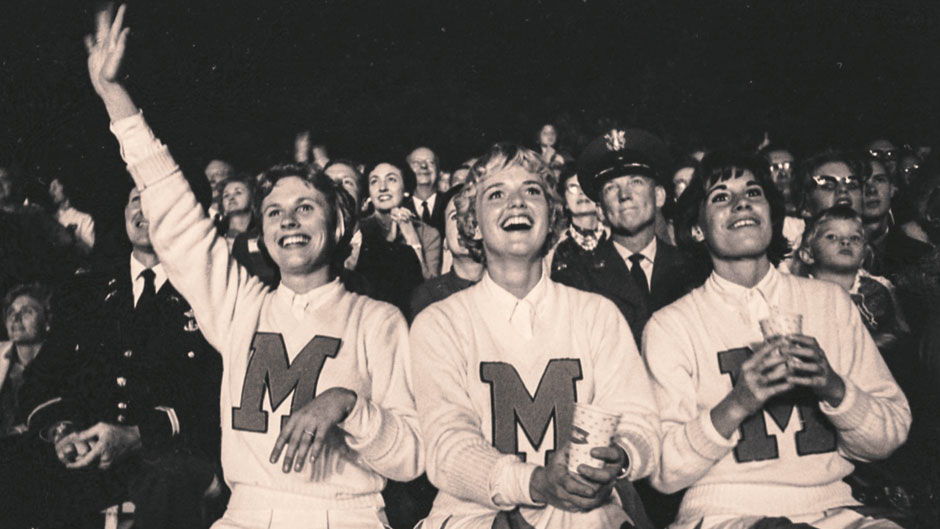Delta Epsilon Started Homecoming Tradition at Miami
The following article appeared on August 15, 2019, via News at The U (news.miami.edu). It was reprinted with permission from Mega Ondrizek, Executive Director of Communications and Public Relations for the University of Miami. The article features the Delta Epsilon/Miami (FL) chapter.
The history behind cherished ’Canes traditions
As students make their way back to campus for the new school year, here’s a refresher on some of the longest standing traditions in the University’s history.
New students, don’t be alarmed when you hear the persistent sound of drumming coming from the Iron Arrow Mound on the Foote University Green, or wonder why there are ornaments dangling from an orange tree near the Ashe Administration Building when Homecoming season comes around.

Joining the University of Miami family comes with a litany of traditions and festivities that you won’t find anywhere else but at the U.
ince welcoming its first students in 1926, UM has established customs involving campus life, experiences, sporting events, and more. Some are old and some were born more recently—but they all play an important role in the life of a ’Cane.
“Even our relatively young University has many time-honored traditions that have been passed on from one generation of ’Canes to the next,” said Joshua R. Brandfon, senior director of Student Activities, Student Organizations and Student Center Complex Programs. “These special student-led traditions remind all ’Canes that they are a part of a thriving university with a rich legacy.”
School colors
’Canes proudly wear the colors orange, green, and white with honor but many may not be familiar with when and how the colors were selected. In 1926, the colors were chosen to represent the Florida orange tree. Orange symbolizes the fruit of the tree, green represents the leaves, and white the blossoms.
Spirit tree
Although small in stature, this campus landmark holds an immense significance to alumni, students, faculty, and staff. Each year the tree is decorated with custom-made ornaments by organizations participating in UM Homecoming. The Association of Commuter Students won the spirit tree competition in 2018.
The seal
The University Seal is embedded in various locations on campus--namely in front of the Campus Store. It is UM tradition to avoid stepping on the seal out of respect for the university’s history. Legend has it that if you do step on the seal, you will not earn your degree from UM.
The mascot
Ibises are known to be birds of courage, knowledge, strength, and speed. Myth maintains that the ibis is the last sign of wildlife to take shelter before a hurricane and the first to reappear after the storm, a symbol of resilience and renewal.
During the 1950s, the ibis reference grew in popularity among the students. By 1957 San Sebastian Hall, a residence hall on campus, sponsored an ibis entry in the Homecoming celebration. The next year, student John Stormont performed at games in a homemade ibis costume. It was later adopted as the official mascot for the University’s athletic teams and is widely considered one of the most recognizable college mascots in the United States.
In 1927, the University’s football team held a meeting to select the name “Hurricanes,” hoping they would sweep away opponents just as devastating as the 1926 storm did the year prior, on September 16.
Four fingers
Football season officially begins August 23, so note this tidbit. At the start of the fourth quarter at every home football game, Miami players and fans will hold up four fingers. This is a sign to indicate that games are won in this crucial period, and they own the last quarter.
Alma Mater
In 1926, William Lampe wrote the words to the Alma Mater on the back of an envelope of an overdue bill from a printer and tapped pianist Christine Asdurian to compose the music. Nowadays, the Alma Mater is taught to all incoming first-year and transfer students at ’Canes Take Flight, and sung during sporting and campus events with pride.
Homecoming boat burning
When night falls the day before the annual Homecoming football game, all eyes will be on Lake Osceola as thousands of ’Canes gather for one of the University’s most cherished traditions: the boat burning ceremony and fireworks. Is it believed that if the mast of the boat falls before the boat sinks, UM will win the Homecoming football game.
This year, the Miami Hurricanes football team will take on the Louisville Cardinals at Hard Rock Stadium on Saturday, November 10.
In 1956, the boat burning tradition started as an effort to promote Theta Chi, a new fraternity on campus that year. At the time, Student Union Director Norman A. Whitten was looking for a student-run event to commemorate the 30th anniversary of Homecoming Week. In the 1960s, after years of boats being burned and settling at the bottom of Lake Osceola, environmental concerns grew. As a response, the boats were excavated and the event continued with environmentally-friendly materials from then on.
“I would consider that to be the most special and ‘unique-to-UM’ tradition,” said Brandfon. “Many schools do parades, block parties – but nobody is blowing up a boat on their lake!”
Iron Arrow
One of UM’s most sacred and established traditions is the gathering of Iron Arrow Honor Society members on the Mound atop the Foote University Green as they prepare to tap new members into the organization each semester. You won’t be able to miss them in their distinctly recognizable jackets, which are handcrafted by Miccosukee artisans.
Founded in 1926 by University President Bowman Foster Ashe and student Francis Spencer Houghtailing, the society is a privileged honor. The Iron Arrow ritual and tradition was established through a relationship initially with the Seminole Nation, and currently with the Miccosukee Tribe of Indians of Florida.
You may view the original article by clicking here.



